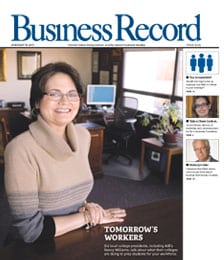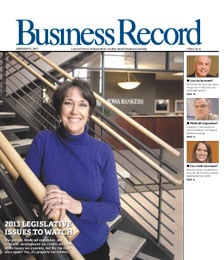Some companies raising dividends

Is it the improving economy (an estimated 6 percent growth to gross domestic product in the third quarter), or are the Bush tax cuts passed earlier this year beginning to drive some action in Iowa’s corporate boardrooms?
It’s too early to call it a trend, but in recent months, three Iowa companies have raised their dividend considerably. In two of the cases, the change was dramatic.
In August, Winnebago Industries Inc. said it doubled its dividend. The change, which means the company will now pay shareholders a quarterly dividend of 10 cents per share instead of paying them that amount every six months, was the first in seven years.
Over the last six years, the Forest City-based company has experienced substantial increases in its sales and profits, one of the cadres of firms benefiting as America’s wealthy baby boomers begin to retire.
Revenues have doubled to $828.4 million in 2002 from 1997. Net income has more than doubled during the same period, rising to $54.7 million, or $2.68 per share, from $23 million, or 90 cents.
Another constant at Winnebago has been a steady buyback of its shares. The company had 25.5 million shares outstanding in 1997. On Oct. 20, it agreed to spend $64 million to buy 1.45 million shares from Hanson Capital Partners LLC, which is owned and controlled by the family of Winnebago founder John K. Hanson. Following the purchase, Winnebago will have 16.8 million shares outstanding.
The company spent $15.5 million on its new manufacturing facility in Charles City and has a capital expenditure budget of $25 million this year, a higher than normal figure, according to Chief Financial Officer Ed Barker.
With the Charles City plant up and running – the company has hired 450 workers so far and is looking for more – management felt the best way to invest its cash was to pay back shareholders, Barker said.
When it came to raising dividends, Barker said that management has “had it on our minds for a year or so.” What pushed them forward was the Bush tax cut, he said.
“We knew we had some capital expenditures that were rather costly this year, and then of course when the taxation bill went through, it helped make that decision a lot easier,” he said. “One of the things we did not like prior to the tax change was that profits were taxed not only at the corporate level, but also taxed at the individual level. It’s a difficult burden for shareholders to bear.”
In June, Casey’s General Stores Inc. boosted its quarterly dividend 40 percent to $0.035 per share from $0.025. The Ankeny-based company paid the first of its higher dividends Aug. 15.
Sales at Casey’s have risen 73.7 percent since 1999, though net income has remained essentially flat, dipping to $39.5 million, or 80 cents per share, from $40.2 million, or 76 cents, in 1999. The company operates on a fiscal calendar that ends April 30. Casey’s has a regular policy of bumping its dividend, which stood at 6 cents per share in fiscal 1999. In 2001, it was increased to 7.5 cents, and was raised again to 8.5 cents in 2002. In 2003, it stood at 10 cents.
The latest company to raise its dividend was Principal Financial Group Inc., which just celebrated its second year as a publicly traded company. The 80 percent increase, to 45 cents per share from 25 cents, was done as a result of a “multitude of factors, including the results of operations, our financial condition, cash requirements and future prospects,” said Tina Marchetti, a Principal spokeswoman.







